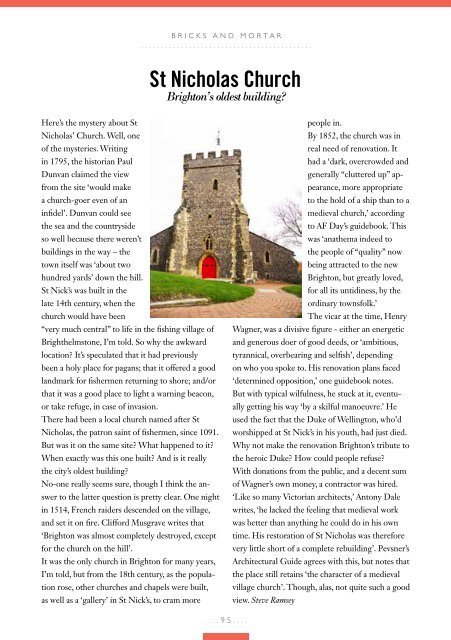You also want an ePaper? Increase the reach of your titles
YUMPU automatically turns print PDFs into web optimized ePapers that Google loves.
icks and mortar<br />
...........................................<br />
St Nicholas Church<br />
<strong>Brighton</strong>’s oldest building?<br />
Here’s the mystery about St<br />
Nicholas’ Church. Well, one<br />
of the mysteries. Writing<br />
in 1795, the historian Paul<br />
Dunvan claimed the view<br />
from the site ‘would make<br />
a church-goer even of an<br />
infidel’. Dunvan could see<br />
the sea and the countryside<br />
so well because there weren’t<br />
buildings in the way – the<br />
town itself was ‘about two<br />
hundred yards’ down the hill.<br />
St Nick’s was built in the<br />
late 14th century, when the<br />
church would have been<br />
“very much central” to life in the fishing village of<br />
Brighthelmstone, I’m told. So why the awkward<br />
location? It’s speculated that it had previously<br />
been a holy place for pagans; that it offered a good<br />
landmark for fishermen returning to shore; and/or<br />
that it was a good place to light a warning beacon,<br />
or take refuge, in case of invasion.<br />
There had been a local church named after St<br />
Nicholas, the patron saint of fishermen, since 1091.<br />
But was it on the same site? What happened to it?<br />
When exactly was this one built? And is it really<br />
the city’s oldest building?<br />
No-one really seems sure, though I think the answer<br />
to the latter question is pretty clear. One night<br />
in 1514, French raiders descended on the village,<br />
and set it on fire. Clifford Musgrave writes that<br />
‘<strong>Brighton</strong> was almost completely destroyed, except<br />
for the church on the hill’.<br />
It was the only church in <strong>Brighton</strong> for many years,<br />
I’m told, but from the 18th century, as the population<br />
rose, other churches and chapels were built,<br />
as well as a ‘gallery’ in St Nick’s, to cram more<br />
people in.<br />
By 1852, the church was in<br />
real need of renovation. It<br />
had a ‘dark, overcrowded and<br />
generally “cluttered up” appearance,<br />
more appropriate<br />
to the hold of a ship than to a<br />
medieval church,’ according<br />
to AF Day’s guidebook. This<br />
was ‘anathema indeed to<br />
the people of “quality” now<br />
being attracted to the new<br />
<strong>Brighton</strong>, but greatly loved,<br />
for all its untidiness, by the<br />
ordinary townsfolk.’<br />
The vicar at the time, Henry<br />
Wagner, was a divisive figure - either an energetic<br />
and generous doer of good deeds, or ‘ambitious,<br />
tyrannical, overbearing and selfish’, depending<br />
on who you spoke to. His renovation plans faced<br />
‘determined opposition,’ one guidebook notes.<br />
But with typical wilfulness, he stuck at it, eventually<br />
getting his way ‘by a skilful manoeuvre.’ He<br />
used the fact that the Duke of Wellington, who’d<br />
worshipped at St Nick’s in his youth, had just died.<br />
Why not make the renovation <strong>Brighton</strong>’s tribute to<br />
the heroic Duke? How could people refuse?<br />
With donations from the public, and a decent sum<br />
of Wagner’s own money, a contractor was hired.<br />
‘Like so many Victorian architects,’ Antony Dale<br />
writes, ‘he lacked the feeling that medieval work<br />
was better than anything he could do in his own<br />
time. His restoration of St Nicholas was therefore<br />
very little short of a complete rebuilding’. Pevsner’s<br />
Architectural Guide agrees with this, but notes that<br />
the place still retains ‘the character of a medieval<br />
village church’. Though, alas, not quite such a good<br />
view. Steve Ramsey<br />
....95....


















